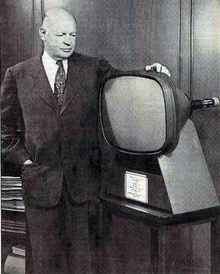Allen B. DuMont
| Allen B. DuMont | |
|---|---|

DuMont with first 21-inch color TV picture tube (1954)
|
|
| Born | Allen Balcom DuMont January 29, 1901 Brooklyn, New York, U.S. |
| Died | 14 November 1965 (aged 64) Montclair, New Jersey, U.S. |
| Nationality | American |
| Fields | Electronics engineer |
| Institutions | Westinghouse Lamp Company DuMont Laboratories |
| Alma mater | Rensselaer Polytechnic Institute |
| Known for |
Cathode ray tube radar founded DuMont Television Network |
| Notable awards | First recipient of the Westinghouse Award (now the Intel Science Talent Search) |
Allen Balcom DuMont, also spelled Du Mont, (January 29, 1901 – November 14, 1965) was an American electronics engineer, scientist and inventor best known for improvements to the cathode ray tube in 1931 for use in television receivers. Seven years later he manufactured and sold the first commercially practical television set to the public. In June 1938, his Model 180 television receiver was the first all-electronic television set ever sold to the public, a few months prior to RCA's first set in April 1939. In 1946, DuMont founded the first television network to be licensed, the DuMont Television Network, initially by linking station WABD (named for DuMont) in New York City to station W3XWT, which later became WTTG, in Washington, D.C. (WTTG was named for Dr. Thomas T. Goldsmith, DuMont's Vice President of Research, and his best friend.) DuMont's successes in television picture tubes, TV sets and components and his involvement in commercial TV broadcasting made him the first millionaire in the business.
DuMont was born in Brooklyn, New York City. At the age of 10, he was stricken with polio and was quarantined at his family's Eastern Parkway apartment for nearly a year. During his quarantine, his father brought home books and magazines for the young DuMont to read while bedridden. At this time, DuMont developed an interest in science, specifically wireless radio communication, and taught himself Morse code.
His father bought him a crystal radio receiver, which he assembled, took apart, reassembled and rebuilt several times. He improved his set each time he rebuilt it and later built a transmitter, while his father obtained the landlord's permission to erect a 30-foot-high (9.1 m) transceiving antenna on the roof.
...
Wikipedia
